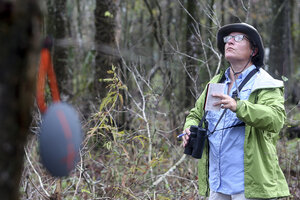Great Backyard Birdcount begins Feb. 17: how citizen-scientists can participate
Amid concerns about climate change and habitat destruction, thousands of citizen-scientists look to the skies to track the progress of birds as the Great Backyard Bird Count begins.

A woman looks for birds off of La. 20 near Chackbay, La., on Jan. 2, 2017, as part of the Annual Christmas Bird Count. The Great Backyard Birdcount runs Feb. 17-20, 2017.
Abby Tabor/The Houma Daily Courier/AP
Across the country, amateur birders will head to their backyards this weekend to count animals in the sky: the annual Great Backyard Bird Count has commenced.
Since it was launched in 1998 by the Cornell Lab of Ornithology and the National Audubon Society, the Great Backyard Bird Count has occurred for four days every February. During this year’s event, from Feb. 17 to Feb. 20, citizen-scientists are invited to go outside and identify all of the birds they see – for as little as 15 minutes, although many devoted birders spend all day – and then submit their observations to the Great Backyard Bird Count website.
Birders across the US are gearing up to participate with bird walks in their own communities.
In the small town of Marion in southwest Virginia, the Hungry Mother State Park will host a free event Saturday morning. Volunteers will offer new birders a “bird walk” with tips on how to identify birds. The Spring Creek Prairie Audubon Center in Denton, Neb., is offering similar bird walks Friday and Saturday morning.
Some local counts offer educational events for the whole family. In Otter Creek Lake and Park in Toledo, Iowa, on Saturday, the Tama County Nature Center is hosting a free event complete with birding lessons, hot cocoa, and activities for kids. And the Harrison Hills Park’s Environmental Learning Center in Natrona Heights, Penn. will provide visitors with books, binoculars, and experienced volunteers, so new birders can get the most out of their bird count.
Don Torino, the president of the Bergen, New Jersey Audubon Society chapter, will offer interested birders a more immersive experience on Sunday: a 90-minute walk along the Teaneck Creek to count various bird species.
Citizen bird counts allow scientists “to get the ‘big picture’ about what is happening to bird populations,” explains the website of the Great Backyard Bird Count.
A paper published Monday in the journal Nature Climate Change reports that the stresses from climate change on birds is much higher than previous estimates. The threat to North American's migratory birds, in particular, brought together an international coalition for the first time last year to find solutions to save them from extinction.
And thanks to the internet, citizen-scientist observations have become vital to reporting changes in the health of bird populations.
“That’s the only way you can really keep track of things that are so widespread,” Pat Leonard, of the Cornell Lab of Ornithology, told the Monitor during last year’s bird count. “Data sets for birds are probably one of the most complete that we have because people have been watching for so long.”
In additional to the Great Backyard Bird Count, there is also the Christmas Bird Count, Project Feeder watch, and ebird, which all enable citizen-scientists to assist researchers in determining the current state of migratory birds.
During the 2014 bird count, for example, ornithologists learned important information about Snowy Owls. Data highlighted “a large irruption” of Snowy Owls across the northeast and Great Lakes area – a signal to the effects of a warming climate on bird movement in the US.
Scientists also hope that getting people outside and connecting with nature will make them more committed stewards of the environment.
“The more that we connect with birds and their habitats, whether begin engulfed by the pre-dawn chorus on a spring morning or identifying our first spotted towhee foraging deep in scrub oak,” Tyler Stuart, a board member of Colorado Spring’s local chapter of the Audubon Society, tells the Colorado Springs Gazette, “the more likely it is that we will speak up when a bird or its habitat is threatened.”
In 2016, birders submitted more than 160,000 lists of observations from more than 130 countries, identifying 5,689 different species of birds.

